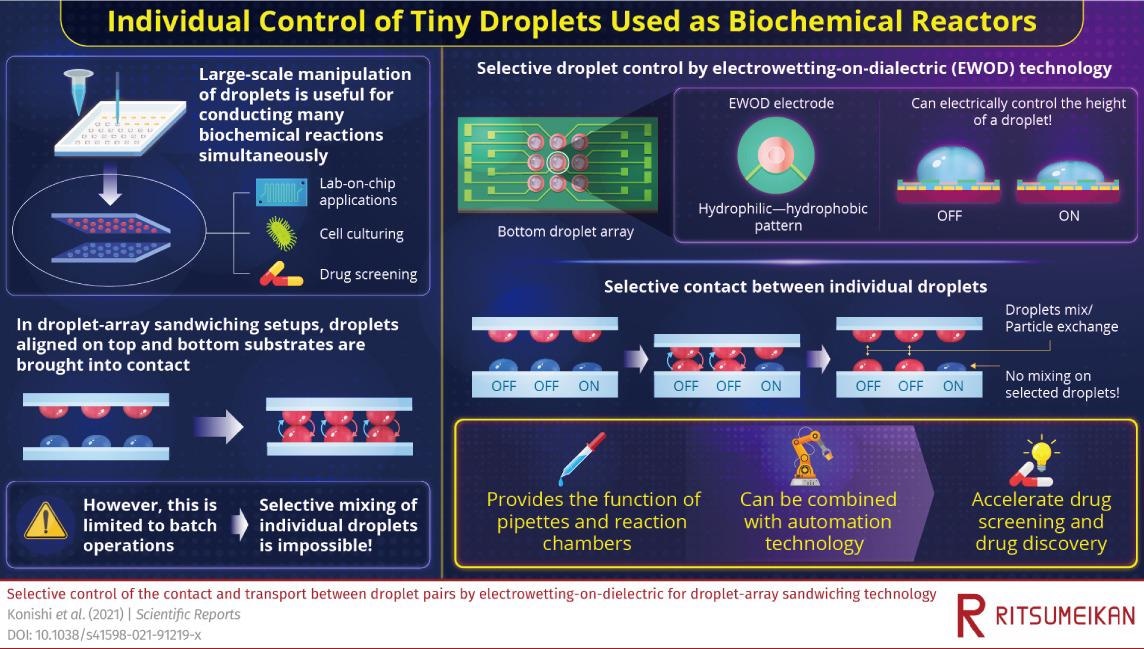所谓的“液滴阵列夹层”是一种液体处理方法,其中通过使表面更近的表面结合在对面表面上的小液滴对。但是,此方法仅限于包含所有液滴的批处理操作。
 日本Ritsumeikan大学的科学家开发了一种方法,可以更好地操纵小滴在片上实验室,用于生物化学,细胞培养和药物筛查。图片来源:日本Ritsumeikan大学。
日本Ritsumeikan大学的科学家开发了一种方法,可以更好地操纵小滴在片上实验室,用于生物化学,细胞培养和药物筛查。图片来源:日本Ritsumeikan大学。
来自Ritsumeikan University, Japan, recently discovered an approach to electrically regulating the height of separate droplets, thereby enabling them to choose which droplet pairs must unite. Their technique could help replace manual tools like pipettes and expedite drug screening.
生物化学领域已迅速改造了微型化,在这里,微流体和“芯片上实验室”设备等新技术正在席卷世界。目前,通常可以在管子和烧瓶中进行的化学反应在不超过几百万升的小水滴中进行。
Especially, in droplet-array sandwiching methods, such small droplets are laid out on two parallel flat surfaces. When the top surface is brought very close to the bottom one, every top droplet tends to contact the opposite bottom droplet, thereby exchanging chemicals and shifting particles or even cells.
在类似的方法中,这样的液滴可以用作小反应室或细胞培养物,它们还可以履行液体处理工具(如移液器)的作用,但规模较小。
液滴阵列夹心的持续问题是缺乏单独的液滴控制。一旦顶部表面降低,底部表面上的每个液滴就与顶部表面的一个液滴接触。
That is, the technology is restricted to batch operations, which hampers its versatility and makes it expensive. The question is whether there are any simple means to choose which droplets must make contact when the surfaces are brought nearer.
Professor Satoshi Konishi and his collaborators at Ritsumeikan University, Japan, responded affirmatively with their research. In a new study published in the科学报告日记研究小组描述了一种新方法,该方法使人们能够单独选择液滴阵列阵列中的液滴。
Their ideas were quite direct: if one could regulate the height of separate droplets on the bottom surface to make some stand taller compared to others, both surfaces could be brought close together in such a way that only those droplets make contact with their counterparts while sparing the remaining ones, but achieving this was a bit complicated.
早些时候,科学家已经尝试使用电力来调节每个液滴下方区域中介电材料的“润湿性”。该方法称为“二循环(EWOD)”,使人们可以稍微修改在静止在表面时共同携带水滴的力平衡。
An electric voltage can be applied under the droplet to make it spread out slightly, which helps increase its area and decrease its height. The researchers, however, found that this process cannot easily be reversed, as droplets would not spontaneously recover their actual height as soon as the voltage is shut down.
为了解决此问题,研究人员开发了具有亲水性疏水性模式的EWOD电极。当电极打开时,较早所述的过程使其顶部的液滴散开,使其更短。
相反,当电极关闭电极时,电极的外部疏水部分将液滴吸收到内部亲水性部分。这恢复了液滴的原始高度和形状。
The scientists exhibited their technique by spreading out several EWOD electrodes on the bottom surface of a droplet-array sandwiching platform. With the application of voltage to chosen electrodes, the researchers could easily select the pairs of droplets that came into contact when the top platform was lowered.
为了进行示范,团队将红色染料从顶液滴转移到了一些底部液滴。
Our approach can be used to electrically set up individual contacts between droplets, allowing us to effortlessly control the concentration of chemicals in these droplets or even transfer living cells from one to another。
Ritsumeikan大学教授Satoshi Konishi
这项研究为液滴处理方法和自动化的生产力组合奠定了基础。
We envision that lab-on-chip technology using droplets will replace conventional manual operations using tools such as pipettes, thereby improving the efficiency of drug screening. In turn, this will accelerate the process of drug discovery。
Ritsumeikan大学教授Satoshi Konishi
Konishi解释说,悬挂液滴中的细胞已用于细胞生物学领域,可以帮助对药物和化学物质进行基于细胞的评估,以低成本,因此代表了细胞生物学和生物化学的有用工具。
研究人员认为,他们离享受这项技术的果实并不遥远。
期刊参考:
Konishi,S。,等。(2021)选择性控制液滴对之间的接触和传输,通过滴液阵中的滴定 - 阵列夹层技术。科学报告。doi.org/10.1038/s41598-021-91219-x。
来源:http://en.ritsumei.ac.jp/